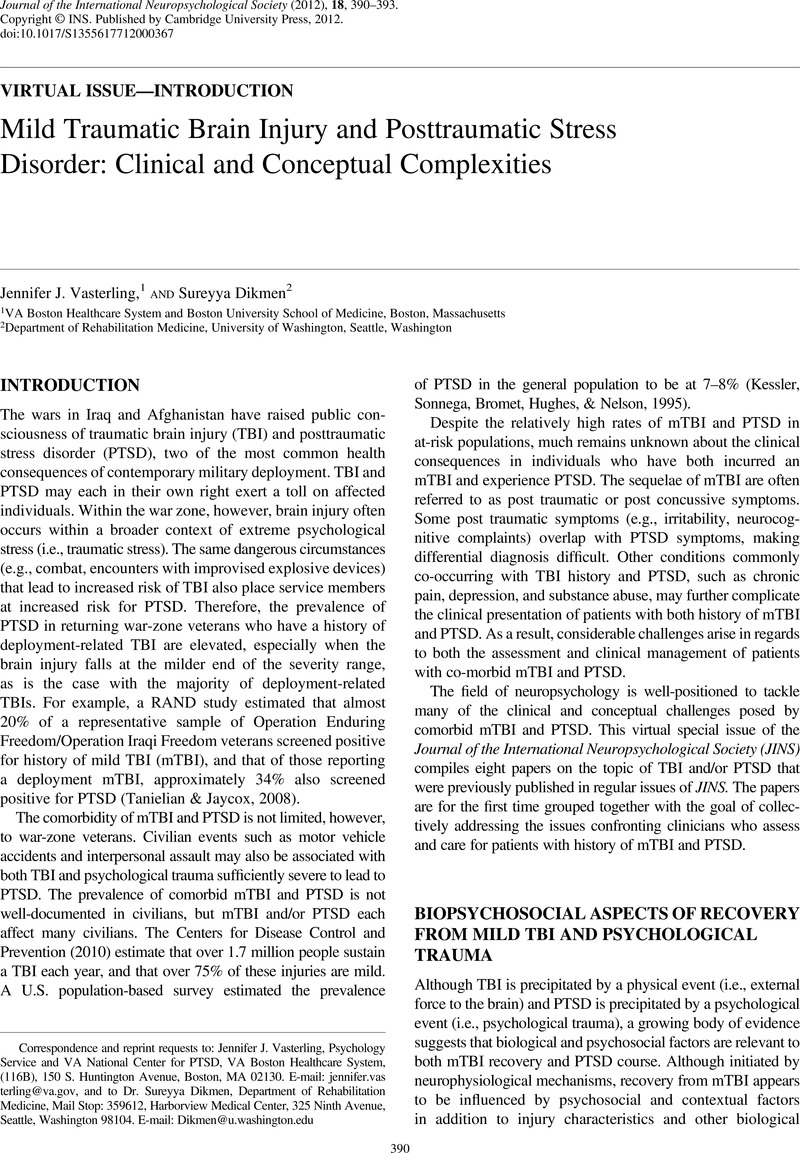Crossref Citations
This article has been cited by the following publications. This list is generated based on data provided by Crossref.
Tate, D. F.
Shenton, M. E.
and
Bigler, E. D.
2012.
Introduction to the brain imaging and behavior special issue on neuroimaging findings in mild traumatic brain injury.
Brain Imaging and Behavior,
Vol. 6,
Issue. 2,
p.
103.
Bigler, Erin D.
2013.
Neuroimaging Biomarkers in Mild Traumatic Brain Injury (mTBI).
Neuropsychology Review,
Vol. 23,
Issue. 3,
p.
169.
Schneider, Jillian C.
2013.
Seminal Treatise on Neuropsychological Practice with Veterans - Neuropsychological Practice with Veterans, Shane S. Bush, (Ed.). 2012. New York: Springer Publishing Company, 424 pp., $70.00 (PB)..
Journal of the International Neuropsychological Society,
Vol. 19,
Issue. 3,
p.
364.
Soble, Jason R.
Spanierman, Lisa B.
and
Fitzgerald Smith, Julie
2013.
Neuropsychological functioning of combat veterans with posttraumatic stress disorder and mild traumatic brain injury.
Journal of Clinical and Experimental Neuropsychology,
Vol. 35,
Issue. 5,
p.
551.
Balakathiresan, Nagaraja
Sharma, Anuj
Chandran, Raghavendar
Bhomia, Manish
Zhang, Zhiqun
Wang, Kevin
and
Maheshwari, Radha
2014.
Biomarkers of Brain Injury and Neurological Disorders.
p.
76.
McGlinchey, Regina
Fortier, Catherine
Venne, Jonathan
Maksimovskiy, Arkadiy
and
Milberg, William
2014.
Effects of OEF/OIF-Related Physical and Emotional Co-Morbidities on Associative Learning: Concurrent Delay and Trace Eyeblink Classical Conditioning.
International Journal of Environmental Research and Public Health,
Vol. 11,
Issue. 3,
p.
3046.
Karr, Justin E.
Areshenkoff, Corson N.
Duggan, Emily C.
and
Garcia-Barrera, Mauricio A.
2014.
Blast-Related Mild Traumatic Brain Injury: A Bayesian Random-Effects Meta-Analysis on the Cognitive Outcomes of Concussion among Military Personnel.
Neuropsychology Review,
Vol. 24,
Issue. 4,
p.
428.
Bailie, Jason M.
Cole, Wesley R.
Ivins, Brian
Boyd, Cynthia
Lewis, Steven
Neff, John
and
Schwab, Karen
2015.
The Experience, Expression, and Control of Anger Following Traumatic Brain Injury in a Military Sample.
Journal of Head Trauma Rehabilitation,
Vol. 30,
Issue. 1,
p.
12.
Bremner, J. Douglas
2016.
Posttraumatic Stress Disorder.
p.
317.
Bailie, Jason M.
Kennedy, Jan E.
French, Louis M.
Marshall, Kathryn
Prokhorenko, Olga
Asmussen, Sarah
Reid, Matthew W.
Qashu, Felicia
Brickell, Tracey A.
and
Lange, Rael T.
2016.
Profile Analysis of the Neurobehavioral and Psychiatric Symptoms Following Combat-Related Mild Traumatic Brain Injury.
Journal of Head Trauma Rehabilitation,
Vol. 31,
Issue. 1,
p.
2.
Radhakrishnan, Rajiv
Garakani, Amir
Gross, Lawrence S
Goin, Marcia K
Pine, Janet
Slaby, Andrew E
Sumner, Calvin R
and
Baron, David A
2016.
Neuropsychiatric aspects of concussion.
The Lancet Psychiatry,
Vol. 3,
Issue. 12,
p.
1166.
Young, J. Christopher
Roper, Brad L.
and
Arentsen, Timothy J.
2016.
Validity testing and neuropsychology practice in the VA healthcare system: results from recent practitioner survey.
The Clinical Neuropsychologist,
Vol. 30,
Issue. 4,
p.
497.
Kaplan, Gary B.
Leite-Morris, Kimberly A.
Wang, Lei
Rumbika, Kendra K.
Heinrichs, Stephen C.
Zeng, Xiang
Wu, Liquan
Arena, Danielle T.
and
Teng, Yang D.
2018.
Pathophysiological Bases of Comorbidity: Traumatic Brain Injury and Post-Traumatic Stress Disorder.
Journal of Neurotrauma,
Vol. 35,
Issue. 2,
p.
210.
Wolf, Gregory K.
Mauntel, Gregory J.
Kretzmer, Tracy
Crawford, Eric
Thors, Christina
Strom, Thad Q.
and
Vanderploeg, Rodney D.
2018.
Comorbid Posttraumatic Stress Disorder and Traumatic Brain Injury: Generalization of Prolonged-Exposure PTSD Treatment Outcomes to Postconcussive Symptoms, Cognition, and Self-Efficacy in Veterans and Active Duty Service Members.
Journal of Head Trauma Rehabilitation,
Vol. 33,
Issue. 2,
p.
E53.
Merritt, Bryan P.
Kretzmer, Tracy
McKenzie-Hartman, Tamara L.
and
Gootam, Praveen
2019.
Neurobehavioral Management of the Polytrauma Veteran.
Physical Medicine and Rehabilitation Clinics of North America,
Vol. 30,
Issue. 1,
p.
133.
Gootam, P.K.
Kretchmer, Tracy
McKenzie-Hartman, Tamara L.
Nikase-Richardson, Risa
Silva, Marc
and
Bajor, Laura
2020.
Concussion.
p.
77.
Fisher, Lauren B.
Bomyea, Jessica
Thomas, Garrett
Cheung, Joey C.
He, Feng
Jain, Sonia
Flashman, Laura A.
Andaluz, Norberto
Coimbra, Raul
George, Mark S.
Grant, Gerald A.
Marx, Christine E.
McAllister, Thomas W.
Shutter, Lori
Lang, Ariel J.
Stein, Murray B.
and
Zafonte, Ross D.
2020.
Contributions of posttraumatic stress disorder (PTSD) and mild TBI (mTBI) history to suicidality in the INTRuST consortium.
Brain Injury,
Vol. 34,
Issue. 10,
p.
1339.
Proessl, Felix
Dretsch, Michael N.
Connaboy, Chris
Lovalekar, Mita
Dunn-Lewis, Courtenay
Canino, Maria C.
Sterczala, Adam J.
Deshpande, Gopikrishna
Katz, Jeffrey S.
Denney, Thomas S.
and
Flanagan, Shawn D.
2020.
Structural Connectome Disruptions in Military Personnel with Mild Traumatic Brain Injury and Post-Traumatic Stress Disorder.
Journal of Neurotrauma,
Vol. 37,
Issue. 19,
p.
2102.
Sorg, Scott F.
Merritt, Victoria C.
Clark, Alexandra L.
Werhane, Madeleine L.
Holiday, Kelsey A.
Schiehser, Dawn M.
Bondi, Mark
and
Delano-Wood, Lisa
2021.
Elevated Intraindividual Variability in Executive Functions and Associations with White Matter Microstructure in Veterans with Mild Traumatic Brain Injury.
Journal of the International Neuropsychological Society,
Vol. 27,
Issue. 4,
p.
305.
Monsour, Molly
Ebedes, Dominique
and
Borlongan, Cesario V.
2022.
A review of the pathology and treatment of TBI and PTSD.
Experimental Neurology,
Vol. 351,
Issue. ,
p.
114009.



